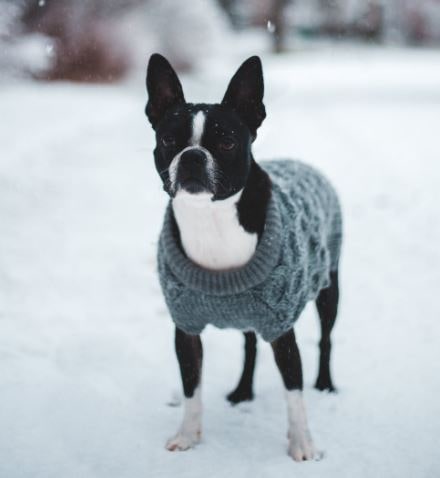Dealing with Itchy Itches: Not so Innocent
It often starts with a simple itch! An irritation that has to be nibbled at and licked until, before you know it, your pet’s itchy spot has turned into an oozing, red, painful patch of bare skin. Quick to develop, hot spots are a nuisance!
Acute Moist Dermatitis, commonly referred to as a Hot Spot, and is also known as a type of pyoderma, is a localized skin infection that can occur anywhere on the body and often in more than one area. Hot spots are often triggered by scratching, licking, or chewing the affected area. The resulting trauma to the skin causes inflammation and secondary bacterial infections. Unfortunately, this self-trauma only makes the area itchier, which causes a self-perpetuating cycle of itching and scratching. While warm and humid weather seems to be the catalyst, any time of the year a hot spot can appear if your pet constantly licks and chews at their skin.
In small animal veterinary practices, pyoderma is one of the leading reasons for a Veterinarian to prescribe systemic antimicrobial agents.1 Pyoderma in dogs is most commonly caused by Staphylococcus pseudintermedius with other staphylococci being involved in less than 10% of cases.2,3 These superficial infections are rarely life-threatening but can significantly increase canine morbidity, leading to decreases in quality of life through subsequent pain, inflammation and pruritus.
CAUSES OF HOT SPOTS
The underlying cause of a hot spot can be anything that triggers an itch. If the itching turns into severe scratching and chewing, the resulting damage to the surface of the skin will prompt rapid bacterial growth. The more damage, the more bacteria, and the greater the itch. Further scratching helps to progressively worsen the hot spot, and the affected area will enlarge quickly. It is a painful cycle for your pet.
Possible causes of hot spots, include:
- Skin parasites, such as fleas and mites
- Allergies, including food, contact, and airborne
- Insect bites or stings
- Ear infections
- Grooming problems, including hair that is matted or tangled or skin that is dirty
- Psychological issues, such as boredom, anxiety, or depression
- Medical conditions resulting in pain that causes the animal to lick and bite an area.
Hot spots can be found on any dog or cat, but the following dog breeds seem more susceptible: Newfoundlands, Pyrenees, and Golden Retrievers or any other dog that have heavy and hairy ears or animals with thick coats and long hair.
SYMPTOMS OF HOT SPOTS
A hot spot can often begin as a small red area that you may mistake for an insect bite. But unlike an insect bite, a hot spot will rapidly worsen and spread, developing into a hot, red, oozing, and painful lesion. Hot spots are very painful, and may cause the animal to be easily irritated or lash out uncharacteristically.
The signs of hot spots include:
- Intense itching
- Sudden onset of a warm, painful and swollen patch of skin that enlarges quickly
- Lesion that exudes pus and has a foul smell
- Rapid loss of hair in the area of the lesion.
How to Treat a Hot Spot or Bacterial Skin Infection
The steps to treat an animal with a hot spot typically involve the following:
- Clip any hair that is over the hot spot. Trimming the hair back will let air reach the area to dry it out and also expose the entire surface area of the hot spot lesion
- Clean the lesion with a mild antiseptic wash. Washing with a mild antiseptic will help to clear the infection from the lesion by removing any surface bacteria and discharge
- Allow the skin to dry thoroughly
- Apply a topical antibiotic/anti-inflammatory ointment, such as an antibiotic steroid cream or powder. Antibiotics will reach the infection in the deeper skin layers. The anti-inflammatory most often prescribed is cortisone, which reduces the itching and discomfort, and stops the animal from scratching and causing further damage to its skin
- If the animal continues to traumatize the area, the veterinarian may prescribe an Elizabethan collar
Research Shows that One Product is Better than the rest
The increasing phenomenon of antimicrobial resistance has been documented in the veterinary literature, prompting the need for alternative therapies to systemic drugs.4–6
To avoid contributing to antimicrobial resistance, Research suggests a shift away from systemic antibiotic use, which can be associated with bacterial resistance, towards the use of topical antiseptics that have different modes of action.
Previous studies have evaluated the antimicrobial effects of topical sprays and shampoos; however, these products are not always practical for owners to apply, especially if the dog has a very long or dense coat. As a result, alternative application formats such as mousses have been developed.
The purpose in one study, was to evaluate the residual antibacterial activity of five different mousse products against S. pseudintermedius (the most common bacterial infection with hot spots) in vitro after in vivo application on canine hairs. In this study Researchers found that treating dogs with the 5 different mousses had surprising results. Some mousses had no effect on the dog’s skin bacterial count and others had some decrease but only ONE had the best results even after 14 days compared to the dog’s skin before treatment. So, what was the best product:
DOUXO Chlorhexidine PS Plus Climbazole Mousse 200 ml
Click here to learn more: https://vetapprovedrx.pharmacy/douxo-chlorhexidine-ps-plus-climbazole-mousse-200-ml.html
PREVENTION
The following information may help your pet from experiencing the discomfort of hot spots:
- When the weather is hot and humid, thoroughly dry the coat of your pet after they have had a bath or have been swimming
- Good grooming practices should be followed. For example:
- Comb and brush coat regularly to remove tangles, prevent matting, and get rid of any foreign debris that may cause an irritation to the skin
- A simple solution, bathe your pet when dirty
- Use flea and tick control preventives regularly
- Routinely wash bedding
- Deter your pet from licking.
Licking an itch seems like a harmless thing to let your pet do, after all we as humans are known to scratch at an itch too. We can relate. But when a pet repeatedly licks and scratches the same area they are prone to painful, swollen and sometimes infected skin areas as a consequence. Hot spots are an itchy and painful problem for your dog or cat, and may become a recurring issue if the underlying condition is not addressed. So it is best to discuss with and bring to the attention of your Veterinarian any area of skin you feel your pet can not stop itching, biting or scratching. Fortunately, with good management, your dog’s hot spot will resolve quickly and will not result in any permanent damage.
To your pet’s good health,
Dr. Barry
Sources
http://www.akc.org/content/health/articles/treating-and-preventing-hot-spots-on-dogs/
http://www.wideopenpets.com/3-common-skin-parasites-dogs-cats/
Residual antibacterial activity of canine hair treated with five mousse products against Staphylococcus pseudintermedius in vitro Sara J. Ramos* , Michelle Woodward*, Sarrah M. Hopp
https://www.akc.org/expert-advice/health/treating-and-preventing-hot-spots-on-dogs/






